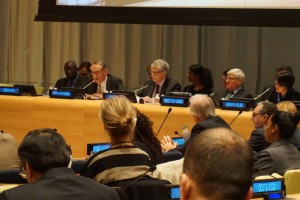Opening remarks by H.E. Mr Mogens Lykketoft, President of the 70th session of the General Assembly, at GA thematic panel discussion on R2P “From Commitment to Implementation: 10 Years of the Responsibility to Protect”
26 February 2016
Excellencies, Mr Deputy Secretary-General, distinguished participants, ladies and gentlemen.
Good morning.
Since the UN’s establishment some 70 years ago, perhaps our greatest failure has been our inability to always protect civilians against atrocity crimes.
The images of those atrocities; the terror and pain felt by vulnerable populations, are embedded in the minds of citizens around the world.
Today, we mark the 10th anniversary of a moment when our leaders said enough is enough.
When, they embraced their individual and shared responsibility to protect populations from genocide, war crimes, ethnic cleansing and crimes against humanity.
The protection of populations, in my view, constitutes one of the main challenges facing our world and the United Nations today.
I have convened this meeting, therefore, so that we can engage in a frank discussion on this issue and reflect on the progress made to date, on current and emerging challenges, and opportunities to accelerate implementation at the global, regional and national levels.
Over the last ten years, the results have been mixed.
Regrettably, we continue to see atrocities happen on our watch, including those taking place in on-going crises and conflicts today.
At the same time, atrocities have been averted; and the Secretary General has set out a framework for implementing this solemn commitment based on three mutually reinforcing pillars.
The responsibility of each individual State to lay the foundations for the protection of populations from these crimes and violations is captured in Pillar number I.
This focus on prevention and resilience-building requires long-term and sustained commitment, as well as targeted policies and actions.
It entails building societies based on inclusiveness, transparency and accountability; building government institutions based on the rule of law and with full respect for human rights and it includes developing appropriate early warning systems in order to adequately respond to potential threats.
While we already have a well tried, comprehensive toolbox at our disposal for Pillar I, we must continue to deepen our understanding of which measures can be most effective.
Pillars II and III look at our collective responsibility for the protection of populations outside our own borders from these crimes and violations.
Pillar II therefore requires that we assist and encourage our partners.
This is not just an abstract consideration.
Member states can encourage and support each other by building systems of resilience including through capacity-building assistance; and by engaging directly to support States that are dealing with periods of crisis.
Pillar III is equally important.
It requires that we consider all tools at our disposal and deploy those that will be most effective in preventing these grave crimes and violations, always in accordance with the United Nations Charter.
Experience demonstrates that timely and decisive response remains essential to protecting populations.
It is also clear that an early, collective response can dampen the determination of potential perpetrators to commit atrocity crimes.
We also know that the choice here is not between inaction and the use of force.
Non-military tools have made a tangible difference in responding to the commission of atrocity crimes and preventing their escalation.
This includes tools, such as mediation, preventive diplomacy, fact-finding missions, special envoys and rapporteurs, referrals to the ICC and targeted sanctions, as well as action by the General Assembly and the Human Rights Council.
We must continue to sharpen these tools and work to better understand their impact.
________
Excellencies, genocide, war crimes, ethnic cleansing and crimes against humanity have wide-ranging costs and long-lasting effects.
The case for accelerating implementation of the responsibility to protect could not be stronger.
And the returns on investments in prevention could not be higher; saving lives; avoiding conflicts; advancing social cohesion and momentum around sustainable development processes.
In his most recent report on the responsibility to protect, the Secretary-General encouraged us to consider a number of priorities for the decade ahead.
Moreover, as we start this second decade of the responsibility to protect, as we look at the challenges which the next Secretary General will face; as we consider the incredible ambition behind the 2030 Agenda; and as we engage in major UN review processes relating to Peace and Security, we have to ask ourselves the hard questions.
Above all, we must ask ourselves what each of us, individually and collectively, will do to address the fundamental weaknesses in international action that have allowed genocide, war crimes, ethnic cleansing and crimes against humanity to occur over the past decade?
We have a distinguished panel today that can help us find answers to such questions.
I encourage you to engage them in an open discussion and to make the most of this opportunity so that we can advance our collective commitment to protect civilians from these grave international crimes and violations.
Thank you very much.


